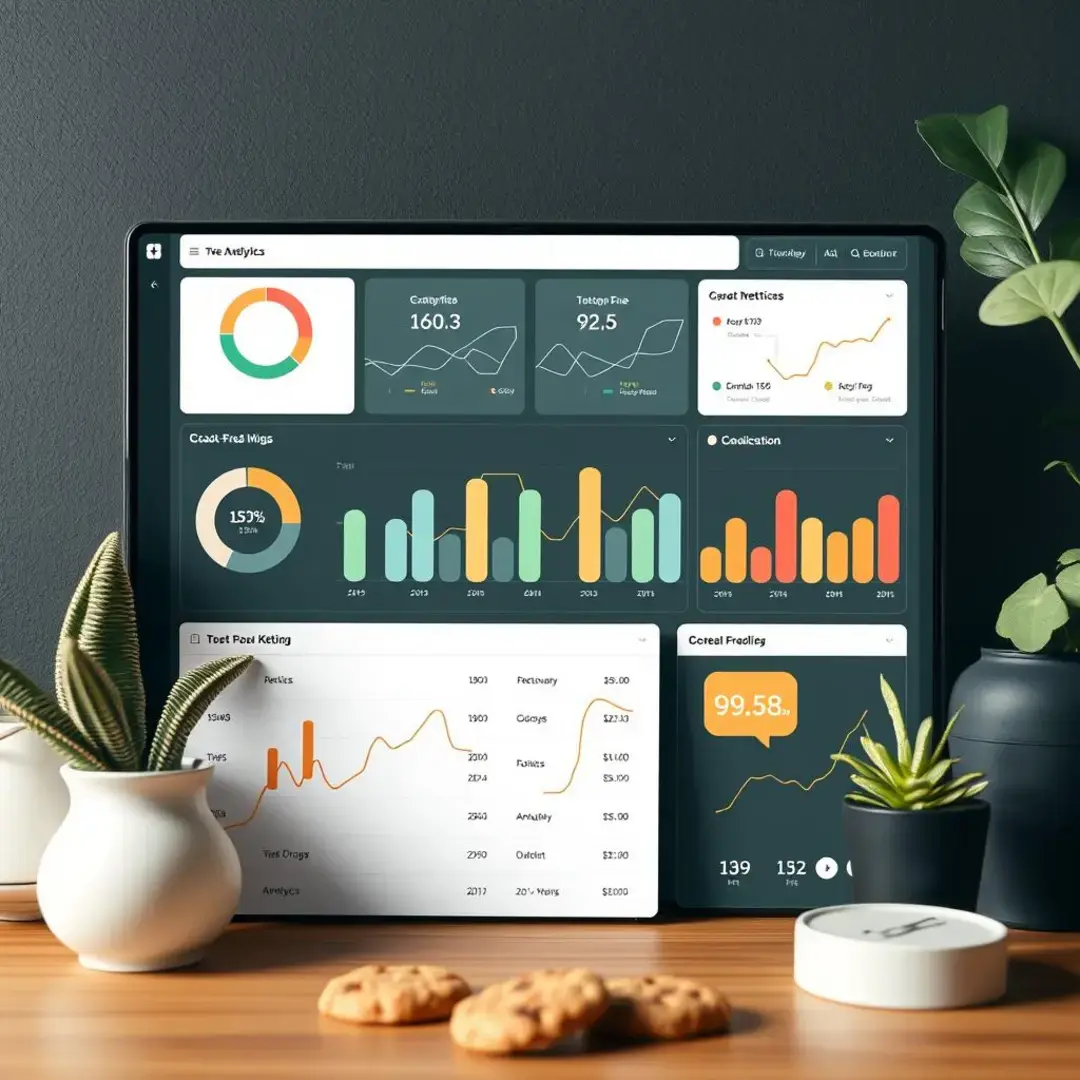Cookie-Free Metrics: KPIs for Inbound Marketing
Understanding the shift away from cookies

The demise of third-party cookies
The rapid advancement of digital privacy is causing a significant shift in the way marketers collect and analyze data. With browsers phasing out third-party cookies, businesses must rethink how they measure success in inbound marketing. In this new landscape, relying on traditional tracking methods is no longer feasible. Marketers must pivot and adopt innovative strategies that respect user privacy while still gaining valuable insights.
Traditional metrics like click-through rates and conversions are affected by the deprecation of cookies. These metrics often relied on tracking users across different sites, but with cookies going away, the reliability of these data points is diminishing. Marketers need to pivot towards metrics that can be gathered through first-party data, which offers a more sustainable and privacy-compliant approach to measuring performance.
In addition to the loss of cookies, privacy regulations have introduced new standards for data collection. Laws, such as GDPR and CCPA, mandate that businesses obtain clear consent from users before collecting and processing their data. This shift places a further emphasis on ethical data usage, encouraging brands to build trust with their customers. Transparency in how data is collected and used will be essential for companies to retain customer loyalty.
Embracing the cookieless future
As the cookie crumbles, first-party data emerges as a vital asset for marketers. First-party data is information collected directly from users, such as website interactions, purchases, or email sign-ups. By investing in robust data collection strategies, businesses can create detailed customer profiles and tailor their marketing efforts more effectively. Utilizing technologies like CRM systems can further enhance the value derived from first-party data.
In a cookieless environment, user experience becomes paramount. Brands must ensure that they provide genuine value to their users, which will naturally encourage engagement. By prioritizing high-quality content, informative resources, and interactive experiences, organizations can establish a favorable perception among their target audiences. When users see a clear benefit in sharing their data, they are more likely to engage positively with brands.
Key performance indicators (KPIs) for a cookieless world

Website engagement metrics
In the absence of cookies, website engagement metrics will play an increasingly critical role. Tracking the time spent on specific pages can provide insights into user interest and content quality. Similarly, analyzing bounce rates can reveal areas where user experience needs improvement. A focus on these metrics empowers marketers to make informed decisions to enhance their content strategies and website usability.
Scroll depth is an effective alternative measure of content engagement. This metric helps determine how far users scroll down a page, indicating their level of interest in the provided information. Coupled with other interactive metrics, such as shares and comments, scroll depth can provide a clearer picture of how effectively content resonates with audiences. Understanding these interactions is crucial for shaping future content creation strategies.
Lead generation and conversion metrics
Tracking lead generation will remain critical in the cookieless landscape. Metrics such as form submissions and the downloads of gated content provide concrete evidence of user engagement. By implementing effective calls-to-action and designing user-friendly forms, businesses can significantly enhance their lead generation efforts. Analyzing this data will help refine strategies and better target segments that bring the most value.
Building a robust email list is vital for ongoing communication and marketing efficacy. Metrics like email sign-ups and newsletter subscriptions are excellent indicators of interested and engaged audiences. By creating compelling content that incentivizes sign-up, marketers can cultivate a loyal following over time. Moreover, this first-party data can be further leveraged to personalize marketing approaches effectively.
Customer lifetime value (CLTV)
Understanding customer lifetime value (CLTV) is paramount for strategic marketing decisions. In the face of cookie deprecation, businesses must develop new methods to measure and predict CLTV effectively. This involves a comprehensive analysis of customer purchasing behavior, retention rates, and overall satisfaction. Metrics derived from first-party data can support a more precise calculation of CLTV, assisting organizations in maximizing their marketing ROI.
Leveraging predictive modeling allows businesses to anticipate customer behaviors and preferences even without cookies. By analyzing historical data and applying algorithms, marketers can identify patterns that indicate future purchasing behaviors. This intelligence can guide marketing strategies and personalized messaging, ensuring that brands are equipped to nurture long-term customer relationships in a privacy-centric landscape.
Advanced strategies for measuring inbound marketing success

Cohort analysis and segmentation
Applying cohort analysis enables marketers to segment users based on shared characteristics or behaviors. By identifying high-value customer segments, businesses can allocate marketing resources more effectively and tailor campaigns that resonate with each group. This granular approach to user analysis fosters smarter decision-making and boosts overall marketing effectiveness.
Once customer segments are established, the next step is to develop personalized campaigns. Tailoring content for specific cohorts enhances relevance and engagement, leading to higher conversion rates. Marketers should implement A/B testing to refine their messaging and strategies continually. This cyclical process increases the likelihood of successfully converting leads into loyal customers.
Attribution modeling beyond last-click
As brands navigate a cookieless world, reconsidering attribution models becomes essential. Multi-touch attribution allows marketers to recognize the various touchpoints that contribute to conversions and overall marketing success. By acknowledging the complete customer journey, brands can allocate budget and focus on the most effective channels. This nuanced understanding can lead to better optimization of marketing strategies and resources.
Utilizing data-driven attribution enables businesses to analyze performance accurately. With advanced analytics, marketers can track interactions and derive insights about how different marketing efforts work together. This leads to a more comprehensive approach to performance measurement, ensuring that every aspect of the marketing funnel is optimized for success. Businesses can build more effective campaigns based on real data rather than assumptions.
Leveraging marketing automation and analytics platforms
In a landscape devoid of cookies, leveraging marketing automation and analytics platforms is critical. These tools enable the integration of various data sources, providing marketers with a holistic view of customer interactions. Such comprehensive insights lead to better-informed decisions, helping businesses understand their audience’s needs and preferences. Additionally, this streamlined approach enhances operational efficiency across marketing teams.
Automating reporting processes helps marketing teams save time and minimize errors. By using analytics platforms that support automated reports, businesses can focus their resources on creating impactful strategies rather than trapped in manual data analysis. This efficiency not only optimizes team productivity but also ensures critical data insights are available promptly, enhancing the overall responsiveness of the marketing efforts.
Future-proofing your inbound marketing strategy

Staying ahead of industry trends and changes
To thrive in a post-cookie landscape, marketing teams must be proactive in understanding privacy regulations. Staying current with industry trends and legal requirements is essential for compliance and maintaining user trust. Organizations need to allocate resources to continuously monitor these changes and adjust their strategies accordingly. Educating marketing teams about new regulations fosters a culture of awareness that supports ethical practices.
Technological advancements often dictate the future of marketing. Organizations that are flexible in adopting new technologies can leverage emerging platforms to connect with their audiences more effectively. From AI-driven analytics to augmented reality experiences, keeping abreast of these innovations allows businesses to stay competitive. Forward-thinking businesses must embrace change and explore how new technologies can enhance their inbound marketing strategies.
Building a sustainable data strategy
As digital privacy concerns continue to rise, businesses must prioritize data security and ethical practices. Implementing robust data governance frameworks not only ensures compliance but also cultivates a trustworthy relationship with customers. Organizations should invest in training and technology that safeguard user data and demonstrate their commitment to upholding privacy standards. Maintaining high data security levels builds brand reputation and customer loyalty.
Finally, investing in data infrastructure and skilled talent is essential for navigating the cookieless future. Equipping teams with the right tools and technologies ensures they can harness valuable insights from first-party data effectively. Moreover, nurturing talent with data analytics skills will empower organizations to make informed decisions and remain strategically agile in a rapidly changing market. By placing an emphasis on skill development, companies can future-proof their marketing endeavors.


